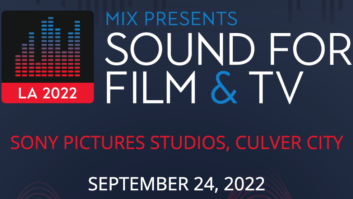Wales, UK (September 17, 2013)—The BBC science fiction series, Doctor Who, celebrates its 50th anniversary this year; while The Doctor always has his Sonic Screwdriver with him, the show’s sound recordist, Deian Humphreys, caries his own set of sonic tools: a Sound Devices 788T-SSD digital audio recorder, 442 field mixer, CL-9 linear fader controller and CL-8 mixing control surface.

As the production sound mixer, Humphreys is charged with recording clean, clear dialog and reducing the amount of ADR needed. That can challenging on a science fiction show that has lots of special effects audio in the background, including smoke, steam and snow machines, as well as a multitude of explosions. Humphreys records the majority of the show using a trolley-based rig, which consists of a Sound Devices 788T-SSD with a CL-9 controller. When on the go, he takes his 788T-SSD using the more portable CL-8 mixing control surface.
“One of the features that I really like about the 788T is that it allows me to easily switch between a Schoeps SuperCMIT digital mic and a Schoeps analog mic without the need for any peripheral equipment,” says Humphreys. “I will often have eight iso-tracks being recorded and two mixed tracks, so the 788T is being driven hard. It always performs incredibly well.”
Humphrey’s on-site audio rig is also necessary for recording special effect voice modulations on a daily basis. The Daleks, the Doctors’ arch-nemeses, are voiced by Nicholas Briggs, who uses his own proprietary secret modulation equipment. “Nicholas will sit by me on set watching my monitors and I will take an output of his magic box and feed that into my 788T,” he says. “I am able to iso that and give him a clean feed of what is happening on the floor. I use the Sound Devices 442 as his monitor, so I’ll feed a clean output into the 442 and give him his Daleks voice on another channel, so he has independent adjustment of his tracks, which he will often mix himself. I can then take another output of his voice and feed it to a loudspeaker on the floor for the actors, and another for the animatronics controllers, who make the lights on the Daleks flash, which serves as a speech recognition tool when they talk. It’s actually quite amazing and all made possible by the 788T-SSD with the 442.”
Humphreys uses the 788T-SSD’s metadata features to ensure everyone knows who’s who on Doctor Who: “When I initially started a year and half ago, I had a long conversation with the dialog editors and one of the requests they had was to match the name of each character with each track. Not just lav 1, lav 2, lav 3, but the character name, so I’m constantly in the 778T-SSD’s track naming menu and I’m re-labeling tracks when different characters come in on those particular mics. That’s such an important feature for me and for the editors, who need to know exactly who is on each track, so they don’t need to waste time pre-listening to tracks to find out who’s on what.”
Sound Devices
www.sounddevices.com







